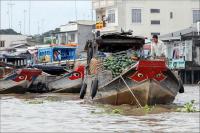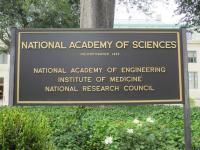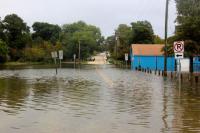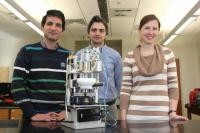-
Changing land uses in California will drive water needs beyond available supply
If past patterns of California land-use change continue, projected water needs by the year 2062 will increase beyond current supply. If historical trends of land use changes to or from urban, agricultural or other uses continue, the result will be increased water-use demand beyond what existing supplies can provide. Large uncertainties associated with weather and climate variability have the potential to exacerbate the problem.
-
-
DHS efforts to address EMP threats to the electric grid fall short: GAO

A report by the Government Accounting Office (GAO) found that as of July 2015, the Department of Homeland Security (DHS) has taken several actions that could help address electromagnetic threats to the electric grid. Although these are positive steps, GAO says that its preliminary work indicates that DHS has not effectively coordinated with stakeholders to identify critical assets or collect necessary risk information, among other responsibilities.
-
-
Bringing energy prices down and keeping the lights on
Peak demand is posing an increasing challenge to the U.K.’s electricity system. Researchers at the University of Oxford have launched a five-year program to investigate ways of relieving peak demands on the U.K.’s electricity grid that also might make energy bills cheaper too.
-
-
Raccoon brings down grid, cutting power to 40,000 Seattle homes
A raccoon broke into a Seattle, Washington power substation on Wednesday morning and single-handedly (some suggest: single-pawedly) brought down the electrical grid, cutting power to more about 40,000 homes. The raccoon did not stay inside the substation for long, but still managed to cause thirteen separate system outages.
-
-
Building security into cyber-physical systems
We are immersed in a cyber-physical world. Information technology is deeply embedded in traditionally non-IT systems, including automobiles, the electric grid and emergency response. But in many of these systems, security is largely incorporated as a last step, like a suit of armor over a vulnerable body. To help bake security into the very core, a new draft NIST publication recommends ways to incorporate time-tested security design principles and concepts into these systems at every step, from concept to implementation.
-
-
Floods, coastal erosion may expose contents of UK landfills
The contents of historic coastal landfill sites in England and Wales could pose a significant environmental threat if they erode, according to a new study. The main risks to these landfills come from the effects of climate change, including erosion and flooding with salt water from storm surges and higher water levels.
-
-
Protecting Texas electrical grid key to preserving national security
Protecting America’s most vulnerable asset – our electric power grid – starts with Texas, according to a new study. “As Texas goes, so goes our national security,” says the study’s author. “Outside of California and the Beltway, Texas is arguably the most important state for defense readiness.” Hardening the state’s electric power grid should be top priority.
-
-
“Internet of Things” increases threat to infrastructure
According to former Director of National Intelligence Dennis Blair, a simple Web search can reveal information from thousands of unsecured devices. Even the casual browser can access camera data from Sweden, video game server activity in Eastern Europe, or the output of American wind turbines. He said this information is as easily accessible to terrorists and other criminals. And more will become available as the “Internet of things” — the collection of physical systems and devices connected to the Internet — grows in size.
-
-
Fixing NYC’s aging infrastructure one engineering problem at a time
How do you make sure aging bridges which are vital links in New York City’s transportation network are safe or keep the city’s sewer system from breaking down? These are among the questions that occupy Columbia University researchers, who have installed sensors to analyze vibration on some of the city’s bridges and in landmark buildings and museums, and have focused on the functioning of the city’s water system.
-
-
More corrosion-resistant water pipes could preventing another Flint, Mich. health crisis
Corrosion-related damage costs more than three percent of the United States’ Gross Domestic Product (about $503.1 billion, going by 2013 numbers). With documented public water problems in Flint, Michigan, and Hoosick Falls, New York, caused by corrosion, understanding how copper is affected at the atomic level is critical to avoiding problems in future pipes.
-
-
Repairing earthquake-damaged bridge columns in days, not weeks
In just thirty seconds, a devastating earthquake like the ones that struck Japan and Ecuador can render a city helpless. With roadways split and bridges severely damaged, residents and emergency personnel could be prevented from moving around to rebuild. Normally, it takes weeks to repair the cracking or spalling of columns on just one bridge damaged in an earthquake. Researchers have developed a new process of fixing columns that takes as little as a few days.
-
-
Rising seas put Vietnam in the “bull’s eye” of rising seas

A rising sea level — for a country like Vietnam, with 2,000 miles of coastline — presents a major environmental and food security challenge, especially in the Mekong River Delta region where 22 percent of the population lives and about half of the country’s food is produced.
-
-
“G-Science” academies call for strengthening global disaster resilience

In the decade between 2005 and 2014, more than 6,000 natural and technological disasters occurred around the world, killing more than 0.8 million people, displacing millions more, and costing more than $1 trillion. Losses due to disasters are increasing in both developed and developing countries. Human factors that increase exposure and vulnerability, such as poverty, rapid population growth, disorderly urbanization, corruption, conflict and changes in land use, poor infrastructure including non-engineered housing, together with effects of climate change on weather patterns with increased extreme events, aggravate the negative consequences of natural and technological hazards.
-
-
New Web portal for coastal resilience

William & Mary Law School and William & Mary’s Virginia Institute of Marine Science (VIMS) are collaborating on a new Web site which will provide key information to support local, regional, and state efforts to adapt to sea-level rise. Tidal and storm surge flooding risks, FEMA flood zone maps, storm history, and critical infrastructure risk assessments are all topics that are likely to be included on the Web site. Information about conditions of shorelines, wetlands, beaches, and coastal forests will also be in the portal.
-
-
Robot offers safer, more efficient way to inspect power lines

Currently, line crews have to suit up in protective clothing, employ elaborate safety procedures, and sometimes completely shut off the power before inspecting a power line. It can be difficult, time-consuming, and often dangerous work. Researchers have invented a robot which could change the way power lines are inspected — providing a safer and more cost-effective alternative.
-
- All
- Regional
- Water
- Biometrics
- Borders/Immig
- Business
- Cybersecurity
- Detection
- Disasters
- Government
- Infrastructure
- International
- Public health
- Public Safety
- Communication interoperabillity
- Emergency services
- Emergency medical services
- Fire
- First response
- IEDs
- Law Enforcement
- Law Enforcement Technology
- Military technology
- Nonlethal weapons
- Nuclear weapons
- Personal protection equipment
- Police
- Notification /alert systems
- Situational awareness
- Weapons systems
- Sci-Tech
- Sector Reports
- Surveillance
- Transportation
Advertising & Marketing: advertise@newswirepubs.com
Editorial: editor@newswirepubs.com
General: info@newswirepubs.com
2010-2011 © News Wire Publications, LLC News Wire Publications, LLC
220 Old Country Road | Suite 200 | Mineola | New York | 11501
Permissions and Policies
Editorial: editor@newswirepubs.com
General: info@newswirepubs.com
2010-2011 © News Wire Publications, LLC News Wire Publications, LLC
220 Old Country Road | Suite 200 | Mineola | New York | 11501
Permissions and Policies
